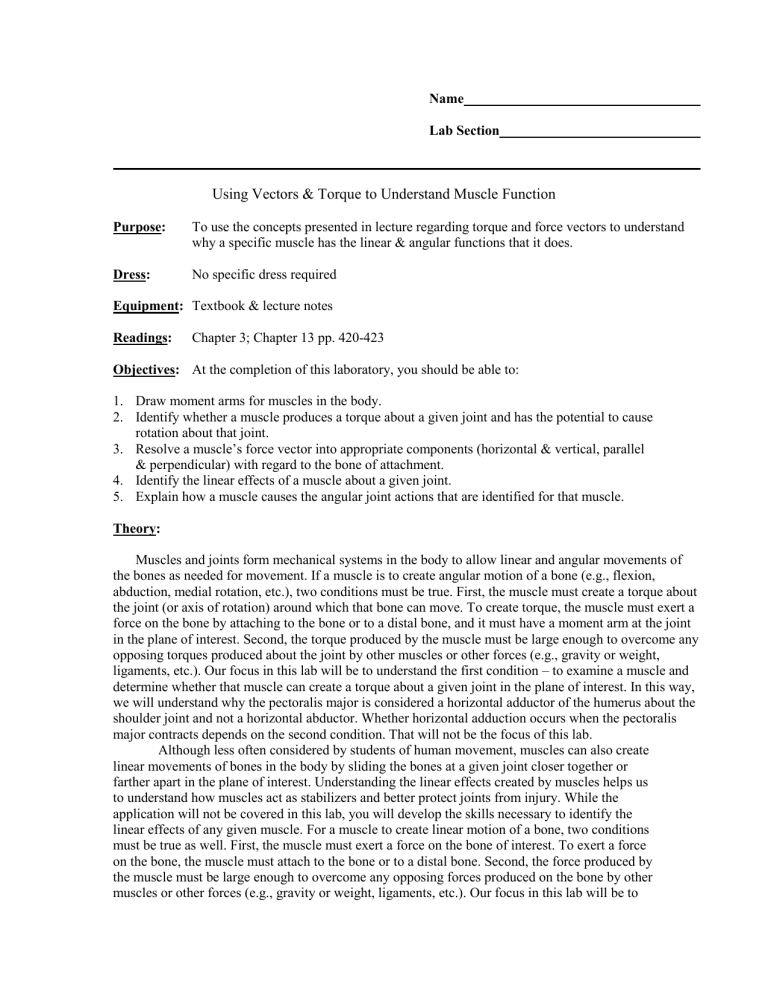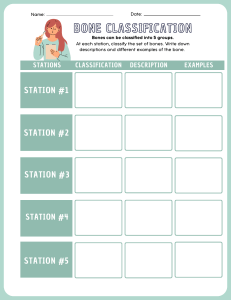
Name Lab Section Using Vectors & Torque to Understand Muscle Function Purpose: To use the concepts presented in lecture regarding torque and force vectors to understand why a specific muscle has the linear & angular functions that it does. Dress: No specific dress required Equipment: Textbook & lecture notes Readings: Chapter 3; Chapter 13 pp. 420-423 Objectives: At the completion of this laboratory, you should be able to: 1. Draw moment arms for muscles in the body. 2. Identify whether a muscle produces a torque about a given joint and has the potential to cause rotation about that joint. 3. Resolve a muscle’s force vector into appropriate components (horizontal & vertical, parallel & perpendicular) with regard to the bone of attachment. 4. Identify the linear effects of a muscle about a given joint. 5. Explain how a muscle causes the angular joint actions that are identified for that muscle. Theory: Muscles and joints form mechanical systems in the body to allow linear and angular movements of the bones as needed for movement. If a muscle is to create angular motion of a bone (e.g., flexion, abduction, medial rotation, etc.), two conditions must be true. First, the muscle must create a torque about the joint (or axis of rotation) around which that bone can move. To create torque, the muscle must exert a force on the bone by attaching to the bone or to a distal bone, and it must have a moment arm at the joint in the plane of interest. Second, the torque produced by the muscle must be large enough to overcome any opposing torques produced about the joint by other muscles or other forces (e.g., gravity or weight, ligaments, etc.). Our focus in this lab will be to understand the first condition – to examine a muscle and determine whether that muscle can create a torque about a given joint in the plane of interest. In this way, we will understand why the pectoralis major is considered a horizontal adductor of the humerus about the shoulder joint and not a horizontal abductor. Whether horizontal adduction occurs when the pectoralis major contracts depends on the second condition. That will not be the focus of this lab. Although less often considered by students of human movement, muscles can also create linear movements of bones in the body by sliding the bones at a given joint closer together or farther apart in the plane of interest. Understanding the linear effects created by muscles helps us to understand how muscles act as stabilizers and better protect joints from injury. While the application will not be covered in this lab, you will develop the skills necessary to identify the linear effects of any given muscle. For a muscle to create linear motion of a bone, two conditions must be true as well. First, the muscle must exert a force on the bone of interest. To exert a force on the bone, the muscle must attach to the bone or to a distal bone. Second, the force produced by the muscle must be large enough to overcome any opposing forces produced on the bone by other muscles or other forces (e.g., gravity or weight, ligaments, etc.). Our focus in this lab will be to 2 understand the first condition – to examine a muscle and determine what kind of linear effects are produced by that muscle. To do this, we will apply the concepts of vector resolution discussed in lecture. Our focus in this lab will be on some of the shoulder complex muscles, since you are currently studying those for your first muscle quiz. Remember from lecture, that resolution for shoulder girdle muscles is typically in the horizontal and vertical directions, while resolution for shoulder joint muscles is parallel and perpendicular to the bone. We will talk more about the application of this process later in the semester. Procedures to be completed prior to the lab session: 1. Read the textbook readings listed above. 2. Review your lecture notes about vector resolution and torque. Procedures to be completed during the lab session: Work in pairs to complete the following for each of the muscles indicated on the following pages: 1. Identify the muscle indicated on the diagram. 2. Identify the plane of view on the diagram. 3. Determine the linear motions in the plane of view by completing the following steps: a. Draw a vector that represents the direction of pull for the muscle in the plane depicted, placing the point of attachment on the bone that reflects the typical movement associated with that muscle. b. Resolve the muscle force vector into its parallel and perpendicular components (for shoulder joint muscles) or horizontal and vertical components (for shoulder girdle muscles). c. As appropriate, identify whether the muscle pulls the bone anterior or posterior, superior or inferior, and/or medial or lateral. 4. Determine the angular motions in the plane of view by completing the following steps: a. Using the original vector that you drew to represent the line of pull for the muscle, draw a moment arm for the muscle in the plane depicted. b. Draw a curved arrow to indicate the direction of rotation created by the muscle. c. Identify whether the muscle has the potential to produce a torque in the plane of view, and if so, identify what kind of torque (e.g., flexion, abduction, medial rotation, etc.). 5. Identify the muscle insertion angle in the plane of view (for shoulder joint muscles only). 6. Visualize the muscle from the other 2 planes not depicted for the muscle, and attempt to “see” the resolution and the moment arm for each plane. You may want to attempt to draw a diagram for each plane. 7. Identify the linear and angular motions in the other 2 planes An example has been done for you on the following page. 3 Downward rotation Elevation – vertical component Retraction – horizontal component Moment arm 4 #1 #2 Muscle: Muscle: Plane: Plane: Linear movements: Linear movements: Angular movement: Angular movement: Muscle insertion angle: Muscle insertion angle: Movements in other planes: Movements in other planes: 5 #3 – About the Elbow #4 Muscle: Muscle: Plane: Plane: Linear movements: Linear movements: Angular movement: Angular movement: Muscle insertion angle: Muscle insertion angle: Movements in other planes: Movements in other planes: 6 #5 #6 Muscle: Muscle: Plane: Plane: Linear movements: Linear movements: Angular movement: Angular movement: Muscle insertion angle: Muscle insertion angle: Movements in other planes: Movements in other planes: 7 #7 #8 Muscle: Muscle: Plane: Plane: Linear movements: Linear movements: Angular movement: Angular movement: Muscle insertion angle: Muscle insertion angle: Movements in other planes: Movements in other planes: 8 Work on only the upper portion of this muscle. #9 #10 Muscle: Muscle: Plane: Plane: Linear movements: Linear movements: Angular movement: Angular movement: Muscle insertion angle: Muscle insertion angle: Movements in other planes: Movements in other planes: 9 Work on only the middle portion of this muscle. #11 #12 Muscle: Muscle: Plane: Plane: Linear movements: Linear movements: Angular movement: Angular movement: Muscle insertion angle: Movements in other planes: ovements in other planes: 10 medial posterior Cross sectional view of the upper arm at the level of the intertubercular groove. #13 Muscle: Plane: Linear movements: Angular movement: Movements in other planes: 11 Questions to be answered and turned in following lab: 1. What was the joint action that you determined for the biceps brachii in the plane depicted in the diagram? Is this a joint action that you normally associate with the biceps brachii? If there is a discrepancy, can you explain why this discrepancy occurs and what the functional implications might be? 2. Other than the biceps brachii, did any of the joint actions that you determined for a given muscle conflict with the actions that are stated for that muscle? Why do you think this might have occurred?




